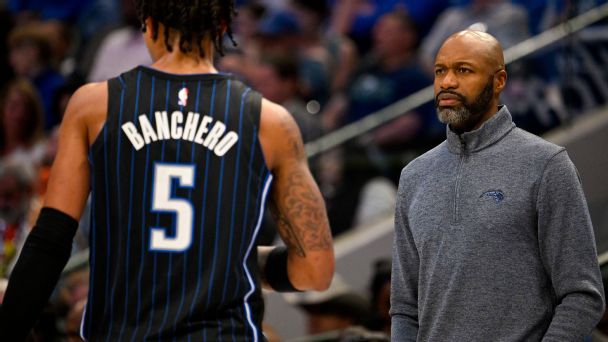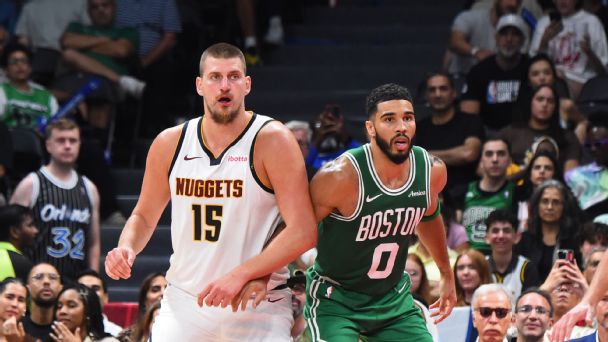Most of the NBA draft dialogue this time of year centers on the first few picks, with teams placed in the spotlight as they prepare to make high-stakes decisions. But further down the draft board, there’s always intrigue to be found, particularly with teams holding multiple selections that have the capacity to remake their roster for the better.
The Orlando Magic hold three 2023 draft picks, including two in the lottery, with a chance to catapult their young roster back into relevance with a strong offseason. The Magic nailed a difficult decision at the top of last year’s draft, landing Paolo Banchero at No. 1, who earned Rookie of the Year honors with a strong campaign.
Orlando’s front office has created a unique team-building opportunity moving forward, with Banchero and Franz Wagner giving them two largely interchangeable playmakers with plus positional size at forward.
What would an ideal draft night look like for the Magic? With the Nos. 6, 11 and 36 picks in hand, the Magic have a big opportunity to add talent this month, whether via the draft or trade. For the sake of the exercise, we’ll operate under the assumption Orlando keeps its picks. And while these things always take time to properly bear out, ESPN’s Jeremy Woo broke down Orlando’s needs and what the best options might look like at each spot.
No. 6 pick: Ausar Thompson | Shooting guard | Overtime Elite
This pick actually presents a somewhat tricky question for the Magic. The feasible candidates at this spot aren’t a perfect fit with their personnel needs because none of the prospects will be excellent shooters from day one. Considering Orlando has two lottery picks, there’s rationale here to simply take a big swing at No. 6, and then directly address the desire to add more shooting at No. 11. And if we work off the assumption that our projected top five — Victor Wembanyama, Brandon Miller, Scoot Henderson, Cam Whitmore and Amen Thompson — are off the board, that leaves Ausar Thompson as an intriguing option.
Factoring Banchero and Wagner’s growing responsibilities as on-ball initiators, Orlando is probably looking at a too-many-cooks situation as far as ball handlers are concerned. But the insertion of a big, versatile defender and additional shot creator alongside them could be a significant help — it addresses a need for a perimeter stopper and two-way option on the wing. The notion of Orlando fielding super-sized, playmaking heavy lineups around Banchero, Wagner and Thompson, who measured 6-foot-5 ¾ barefoot with a 7-foot wingspan at the combine is something to think about.
Thompson could be a significant upgrade defensively in relatively short order with the quickness and versatility to slow smaller guards as well as bigger wings. He’d immediately add a superior physical dimension to a Magic backcourt that includes Markelle Fultz, Jalen Suggs and Cole Anthony. The twin brother of Amen is a naturally tenacious defender who will likely rise to the challenge and improve some of the occasionally lax habits he showed at Overtime Elite.
While some of Thompson’s upside lies in untapped playmaking ability — his brother gets more credit as a passer, but Ausar can also create for others and is a useful playmaker — it does help that he’s accustomed to playing primarily off the ball, allowing the Magic some potential schematic versatility if they draft him.
Thompson is not an accomplished 3-point threat and will require some more time to become a consistent catch-and-shoot option in the NBA. There’s going to be a major adjustment for him as he makes a significant jump in level from OTE to the NBA, which comes with some risk built in. But he did make tangible strides over two years with the fledgling program, and is known as a constant worker, which presumably bodes well for his chances of realizing his full ability.
Ben Sheppard throws down big slam vs. Indiana State Sycamores
No. 11 pick: Gradey Dick | Shooting guard | Kansas
Here’s where the Magic can address the imperative to surround Banchero and Wagner with shooting. If available at No. 11, Dick would be a pretty natural match for Orlando, slotting in at either wing position and providing an immediate floor spacing component to lineups. Landing a player in his mold with plus positional size and who doesn’t need to see much of the ball to be effective could be a pretty seamless fit at this spot. The Magic finished near the bottom of the league in 3-point shooting percentage last season and require better spacing in order for their young stars to develop.
If you figure Banchero, Wagner and whoever the nominal point guard is will handle most of the offensive creation moving forward — in this scenario, Thompson will hopefully take on some of that responsibility in time, as well — and the Magic want to justify making both picks versus trading them, they’ll want a low-maintenance type of player to round things out. A rim-running style big could be an eventual necessity for Orlando, but there’s not a whole lot of depth at center in this class. Perhaps Duke’s Dereck Lively II could figure in here as a potential rim protector and spacing big but I’d lean toward simply taking the best shooter available at this spot.
Dick figures to step in and help an NBA team in relatively short order, with the threat of his shot helping to get him on the floor early in his career. While he’s not as polished or versatile a shooter as UConn’s Jordan Hawkins, Dick’s legitimacy on the wing at 6-foot-7 coupled with his jumper and the potential to diversify his shot-making off the dribble and playing off of movement gives him a strong lottery argument as one of the higher-floor prospects in the draft.
In an exercise like this, second-round picks are much harder to predict, but let’s hypothesize a future where the Magic keep the No. 36 pick and decide to simply double down on the need for shooting and perimeter depth. A flier on someone such as Sheppard, another excellent shooter who could feasibly be available in the 30s, could be a great dart throw for Orlando’s situation and needs. Sheppard broke out at the combine, legitimizing himself as much more than just a mid-major star while showcasing both a reliable 3-point shot (41.6% on more than six attempts per game last season at Belmont) and more floor game than expected, making a variety of nice passes and showing a bit more on-ball ability than many scouts expected. He measured about average for a 2-guard at 6-5¼ with a 6-7¾ wingspan and has the traits to be a useful supporting player in time. One point of caution is he was only a 69.8% free throw shooter in college — perhaps an indicator that his shooting may not translate in an elite capacity — but at the 36th pick, it’s a justifiable swing. Philosophically, the idea is simply to restock as much shooting as possible, particularly in the backcourt, considering how many forward minutes will go to Banchero and Wagner as the Magic evolve. Orlando has some flexibility in creating cap space, which it could potentially use to add some veteran depth up front. The Magic have a lot of guards on the roster, but the value of having inexpensive, cost-controlled shooting is pretty significant, and taking an inexpensive chance on Sheppard’s profile — and hoping for a nice role player — would be an interesting direction in the second round. Jeremy Woo is an NBA analyst specializing in prospect evaluation and the draft. He was previously a staff writer and draft insider at Sports Illustrated.No. 36 pick: Ben Sheppard | Small forward | Belmont



